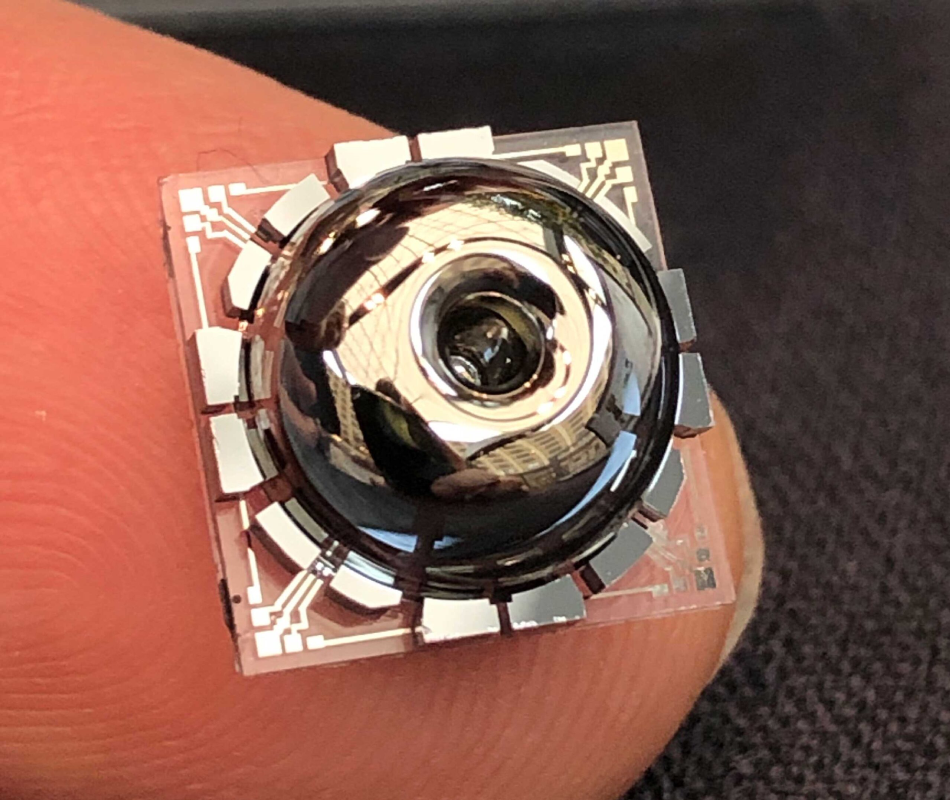Mar 24 2020
The University of Michigan (U-M) has created a tiny, low-cost, and highly precise gyroscope that could aid self-driving cars and drones to remain on track even in the absence of a GPS signal.
 The new resonator and electrodes, on a finger for scale. The resonator is almost perfectly symmetrical, made of nearly-pure glass. This enables it to vibrate for long periods, similar to the ringing of a wine glass. Image Credit: Najafi Group.
The new resonator and electrodes, on a finger for scale. The resonator is almost perfectly symmetrical, made of nearly-pure glass. This enables it to vibrate for long periods, similar to the ringing of a wine glass. Image Credit: Najafi Group.
Our gyroscope is 10,000 times more accurate but only 10 times more expensive than gyroscopes used in your typical cell phones. This gyroscope is 1,000 times less expensive than much larger gyroscopes with similar performance.
Khalil Najafi, Schlumberger Professor of Engineering, Department of Electrical Engineering and Computer Science, University of Michigan
Najafi is also a professor of electrical engineering and computer science at U-M.
A majority of smartphones incorporate gyroscopes to identify the screen’s orientation and help to understand the direction that a user is facing, but the precision of these smartphones is rather limited. This is the reason why smartphones often erroneously indicate the direction a user is facing at the time of navigation.
While this may not be a major concern for people behind the wheel or on the street, an autonomous car could easily become lost in the absence of the GPS signal. Driverless vehicles, within their backup navigation systems, currently utilize high-performance gyroscopes that are not only larger but also relatively costlier.
High-performance gyroscopes are a bottleneck, and they have been for a long time. This gyroscope can remove this bottleneck by enabling the use of high-precision and low-cost inertial navigation in most autonomous vehicles.
Jae Yoong Cho, Assistant Research Scientist, Department of Electrical Engineering and Computer Science, University of Michigan
Improved backup navigation devices may also assist soldiers to find their way in localities where GPS signals are not working. Or in a more ordinary situation, precise indoor navigation can potentially accelerate warehouse robots.
Inertial measurement unit is a device that facilitates navigation without a reliable orienting signal. It contains three accelerometers as well as three gyroscopes, one for every axis in space. However, getting a good read on which direction a user is heading, using present-day IMUs is so costly that it has been beyond the range, even for devices as costly as driverless vehicles.
The key for producing this tiny, low-cost gyroscope is an almost symmetrical mechanical resonator. It resembles a Bundt pan crossed with a wine glass, measuring 1 cm wide. Just like wine glasses, the duration of the ringing tone created upon striking the glass relies on the glass’ quality—but rather than being an appealing feature, the ring is important to the function of the gyroscope. Electrodes located around the glass resonator are used by the entire device to pull and push on the glass, making it ring and sustaining it continuously.
Basically, the glass resonator vibrates in a certain pattern. If you suddenly rotate it, the vibrating pattern wants to stay in its original orientation. So, by monitoring the vibration pattern it is possible to directly measure rotation rate and angle.
Sajal Singh, Doctoral Student, Electrical and Computer Engineering Division, University of Michigan
Singh helped in developing the manufacturing procedure.
The way the vibrating movement passes via the glass indicates when, how quickly, and the extent the gyroscope rotates in space.
To make the resonators as optimal as possible, Najafi’s group began with an almost perfect sheet of pure glass, called fused-silica, which has a thickness of about 1/4 mm. The researchers utilized a blowtorch to primarily heat the glass and subsequently shaped it into a Bundt-like shape—called a “birdbath” resonator because it also looks like an upside-down birdbath.
The team then coated the shell with a metallic coating and positioned the electrodes around it that trigger and quantify the glass’s vibrations. The entire thing is covered in a vacuum package, which is roughly the footprint of a postage stamp and measures 0.5 cm in length, which prevents air from rapidly damping out the vibrations in the glass.
The study titled, “0.00016 deg/√hr angle random walk (ARW) and 0.0014 deg/hr bias instability (BI) from a 5.2M-Q and 1-cm precision shell integrating (PSI) gyroscope,” will be presented at the (now virtual) 7th IEEE International Symposium on Inertial Sensors & Systems on March 25th, 2020.
The Defense Advanced Research Projects Agency funded the study. Both Cho and Najafi are co-founders of Enertia Microsystems, a startup company based on the technology licensed from U-M.